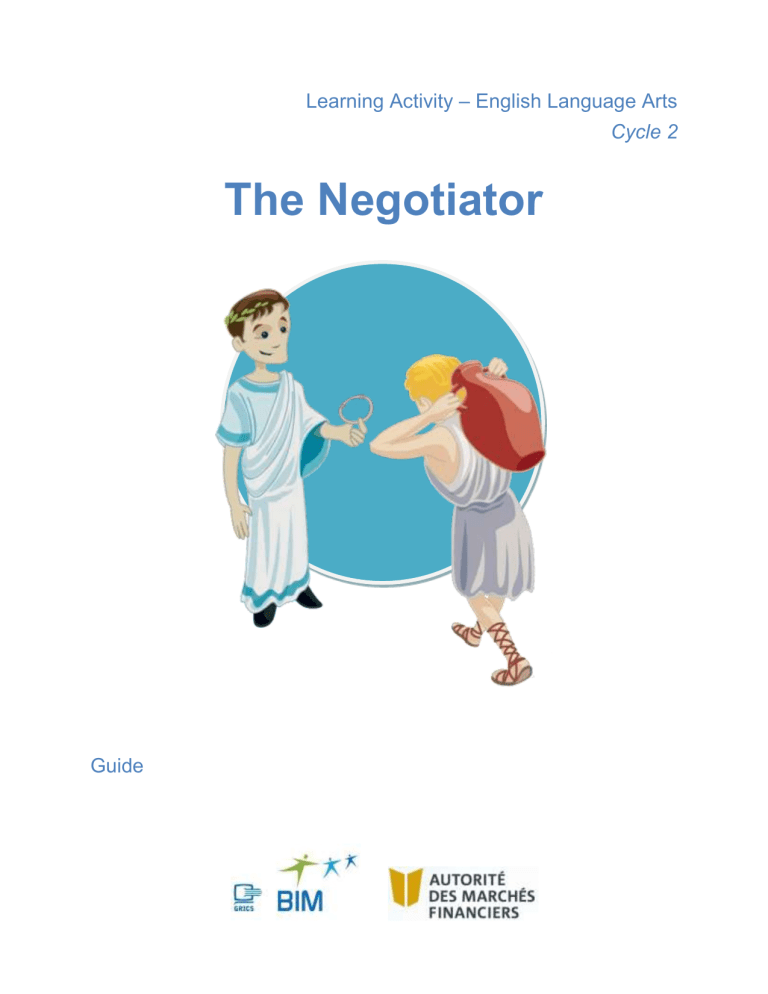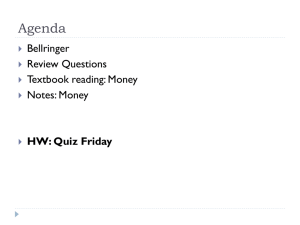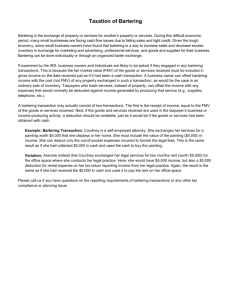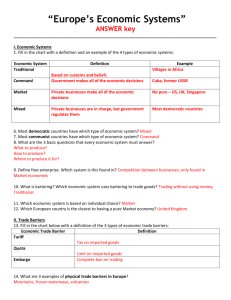Guide - Ekomini

Learning Activity
– English Language Arts
Cycle 2
The Negotiator
Guide
Background Information
Title
The Negotiator
Guiding Question
How can we develop an exchange network in our school?
Cycle
Elementary Cycle 2
Suggested Duration
2 hours
Pedagogical Intention
To help students explore the concept of financial literacy
Competency
English Language Arts – To read and listen to literary, popular and information-based texts
Essential Knowledge
Response Process
Uses a variety of reading strategies to make meaning of different text types
Uses details and evidence in the text to infer meaning(s)
Constructs a personal response to the text
Evaluation
Correction Key
Marking Grid (Appendix D)
Resources
Teacher’s Guide
Student Booklet
Illustrations
Ekomini
Clipart ( http://www.clipart.com
)
Page 1
Summary Chart
The following chart represents four learning activities for Cycle 2. The learning activities are not in sequential order.
Title, Description and
Concept Developed
The Piggy Bank
Students explore more deeply the concept of budgeting as they plan the purchase of sports equipment for a hockey team while respecting budgetary constraints.
Concept developed:
Expenses
Students are invited to create a
Expenses
Using recycled materials, students continue to explore the concept of saving while making a functional 3D piggy bank.
Concept developed:
Saving
The Negotiator
Students explore the concept of barter
Concept developed:
Exchange
I Equip My Team
Koni Spends Too Much repayment plan.
Concept developed:
Discipline and
Competency
Targeted
Visual Arts
C1: To Produce individual works in the visual arts.
English Language
Arts
To read and listen to literary, popular and informationbased texts
Mathematics
C1: To solve a situational problem related to mathematics.
C2: To reason using mathematical concepts and processes.
Mathematics
C2: To reason using mathematical concepts and processes.
Source: Québec, ministère de l’Éducation, du Loisir et du Sport
Progression of Learning
Applications of Knowledge
• To use personal ideas inspired by the stimulus for creation.
• To use transforming gestures and elements of visual arts language.
• To share his/her creative experience.
Knowledge
• Visual Arts
Response Process
• Uses a variety of reading strategies to make meaning of different text types.
• Uses details and evidence in the text to infer meaning(s)
• Constructs a personal response to the text.
Concepts and Processes
• To translate a situation using a series of operations in accordance with the order of operations: addition.
• To develop processes for written computation (addition and subtraction).
• To use his/her own processes as well as objects and drawings to determine the sum or difference of two natural numbers less than 1000.
• To determine the operation(s) to perform in a given situation.
• To develop processes for written computation (addition and subtraction).
• To use his/her own processes as well as objects and drawings to determine the sum or difference of two natural numbers less than 1000.
• To compare natural numbers.
• Vocabulary: is equal to, is greater than, is less than…
Concepts and Processus
• To approximate the result
• To develop processes for written computation (addition and subtraction)
• To develop processes for written computation (multiplication and division)
Page 2
Overview of the Task
After playing a bartering game, students are asked to read a text about the history of bartering.
They then answer questions to demonstrate understanding of the text. Finally, in teams, they must describe an exchange network they would like to develop for their school.
Guiding Question
How can we develop an exchange network in our school?
Preparation Phase
30 minutes
Required Material
Card Game (Appendix A): Print one copy of the appendix for each team of four students.
Phoney Money (Appendix B): Print one copy of the appendix for each team of four students.
Procedure
Lead a class discussion on the concept of bartering by asking students about their personal experiences. o Who has already traded things with a friend? o What type of things did you trade? o Why do you like to trade or exchange things?
Introduce the bartering game.
Bartering Game: A Native American’s Survival Kit
Divide the class into teams of four students.
Each player receives $5 in Phoney Money and a set of six game cards. (Distribute the cards according to the icon found in the corner of the cards.)
The goal of the game is to get all the articles in the Native American Survival Kit as quickly as possible by exchanging cards and money with the other players. The game ends when at least two players out of four have a complete survival kit. The best negotiator is the one who is able to keep the most money.
Optional: The game can be played several times; this way students have the chance to try out new trading strategies. A game just involving the winners may also be played at the end.
Description and value of the articles in the Survival Kit –Appendix A
$3: Necklace
$2: Sash
$1: Moccasins
$1: Dreamcatcher
$2: Tomahawk
$3: Protective Arrowhead
Page 3
Implementation Phase
90 minutes
Required Material
Information-Based Text (Appendix C)
Student Booklet
Procedure
Hand out the Student Booklet .
Ask the students to answer the questions about their personal reading strategies in their
Student Booklet, Part 1.
Ask the students to read the text “Bartering, the Past and the Present”. The story is found in
Part 2 of the Student Booklet .
To ensure understanding of the story, ask the students questions.
As a class, ask the students to identify new words they encountered in the story. Write the words on the board.
Ask the students to answer the questions on pages 4 and 5 of the Student Booklet .
Ask the students to form teams and complete Part 4 of the Student Booklet . As a team they will develop an idea for an exchange network at their school.
Integration Phase
50 minutes
Present the story about the red paperclip found in the news article http://www.msnbc.msn.com/id/13804920/ns/technology_and_sciencetech_and_gadgets/t/bloggers-quest-ends-keys-house/
Refocus on the guiding question, “How can we develop an exchange network in our school?
”
Have each team present their ideas for an exchange network.
As a class, determine the most appropriate exchange network for the school.
Collect the Student Booklets and correct Parts 3 and 4.
Enrichment Activities
As a class project, implement an exchange network at your school.
Page 4
Correction Key
Question 1: In your own words, what is bartering?
Suggested answers (1 mark)
People trade their personal property or their services against other goods or services.
Bartering is trading one object for another.
Question 2: Why do you think that certain countries started “stamping coins” instead of using objects like cows, salt or shells for trading?
Suggested answers (2 marks)
It is easier to carry a pocket full of coins than it is to carry around a cow or a bag of salt.
People could not agree on the value of a certain object compared to another object.
Question 3: Do you think it is better to trade goods using money or by bartering?
Explain.
Suggested answers (2 marks)
It is easier to trade with barter because everyone has something that they can exchange for what they want or need.
Bartering is easier because it doesn't matter if you are rich or poor.
It is easier to trade with money because we can compare the price of various goods easily.
Question 4: Since the early 2000s people have started bartering through websites. Why do you think bartering is still used today?
Suggested answers (2 marks)
Barter allows people to exchange things to get what they need without using money.
During economic crises people are very poor. Bartering can help families get the things they need even if they don't have money.
People from all over the world can easily exchange goods and services through websites.
Question 5: How can bartering help preserve the environment?
Suggested answers (1 mark)
Bartering allows us to reuse and recycle things.
Less things get thrown away and this is good for the environment.
Question 6: Describe a personal experience you have had with bartering or trading.
Accept all answer related to a student’s personal experience. (2 marks)
Page 5
Appendix A – Game Cards
Player 1
$3 Necklace J
1
$1
Player 1
Sash J
1
Player 2
$2 Moccasins J
2
Player 2
$2 Moccasins J
2
$3 Necklace J
1
$1 Sash J
1
$2 Moccasins J
2
$2 Moccasins J
2
$3 Necklace J
1
$1 Sash J
1
$3 Necklace J
2
$1 Sash J
2
Page 6
Player 3 Player 3
$2 Tomahawk J
3
$2 Tomahawk J
3
$3
Player 4
Protective
Arrowhead
J
4
Player 4
$1 Dreamcatcher J
4
$2 Tomahawk J
3
$2 Tomahawk J
3
$3
Protective
Arrowhead
J
4
$1 Dreamcatcher J
4
$3
Protective
Arrowhead
J
3
$1 Dreamcatcher J
3
$3
Protective
Arrowhead
J
4
$1 Dreamcatcher J
4
Page 7
Page 8
Appendix C
Bartering, the Past and the Present
Did you know that humans used to live without money?
Centuries ago, when money did not exist, people bartered. People would trade their property or their services against other goods or services. Examples of bartering are; “If you give me some bread, I will give you some wood ” or “If you help me to collect wood, I will give you a bowl of soup.
”
Later on, people began to exchange goods or services for objects that had value. Salt, tea and cattle were once used like money. Strings of beads made from shells, called wampum, were used by North American Indians as money. However, it was not always easy to carry these objects and sometimes people argued about the value of these objects. How many bags of tea could you trade for a cow?
In other parts of the world people started to use precious metals like silver and gold in exchange for goods and services. A specific amount of the metal would be weighed out and placed between two stencils. Then a man would use a large hammer to flatten out the metal. The stencils left images on both sides of the coin to show how much it was worth. This was the beginning of “stamping coins”.
During the time of the Romans, a bronze coin was called an “as” and a silver coin was called a
“denarius”. Ten bronze coins had the same value as one silver coin, like our dime and penny.
Workers received one “denarius” for a day’s wage. Therefore, a man had to work ten hours to receive his “denarius”, or in other words, he made one “as” per hour.
Page 9
Today, money is the common medium of exchange in most societies on Earth. We use money to pay for our food, clothing, housing, transportation and everything else we need to live. We receive money for the work we do and we use it to pay for all the services that we need.
Despite all the advantages of currency, bartering has never really disappeared. During the Great Depression, people were very poor and bartering enabled them to obtain goods or products that they needed for everyday life. Even today, bartering is used, especially during economic crises.
Since the beginning of the 2000s, new trading networks have been created using websites. Today, these “social networks” bring people together from all over the world and allow them to easily exchange goods and services.
So what will the future bring? We can certainly see that bartering will always be present in our societies. Indeed, it may become even more important, especially with the need to recycle and to preserve our environment.
Page 10
Appendix D
Marking Grid
Retained Evaluation Criteria
Construct Meaning
Information Clarifying the Criteria
• Interpretation and explanation to support ideas when responding to texts
• Integration of new information to construct meaning
Making Connections
• Establishment of text-to-text, text-to-self and text-to-world connections.
Source: QUÉBEC, MINISTÈRE DE L’ÉDUCATION, DU LOISIR ET DU SPORT, Frameworks for the Evaluation of Learning English
Language Arts, Québec, 2011.
Distribution of Marks for the Reading Tasks
Evaluation Criteria Reading Tasks
Number of
Marks
Construct Meaning
Making Connections
Question 1
1 mark
Question 2
2 marks
Question 3
2 marks
Question 4
2 marks
Question 5
2 marks
Question 6
2 marks
PART 4
Description of Exchange
Network
2 marks
9 marks
4 marks
TOTAL 13 points
Percentage of
Total Mark
69 %
31 %
100 %
Page 11






